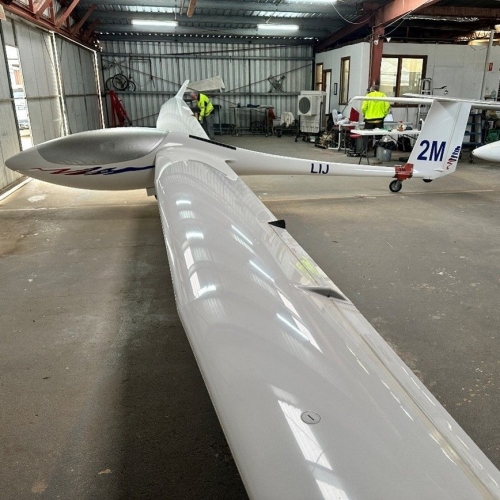
" I have been fortunate enough to recently join a local Victorian syndicate and now own one-third of an Alexander Schleicher GmbH & Co, ASW-28 sailplane - a high-performance Standard Class sailplane with a demonstrated glide ratio of 1:46, meaning from 1 nm high in still air, I can glide for 46 nm (fingers crossed). Thermals, wave lift and the sinking air in-between makes each flight either a brief or longer adventure.
With my first flight in the Schleicher ASW-28 completed just last week, it was time to hit the hangar and learn how to carry out its annual inspection - Gliding Australia’s famous Form 2. Having not completed one previously, it was a great opportunity to not only learn the inspection’s intricacies and procedures from my local club’s extremely experienced and qualified inspectors, but an opportunity to get to know my new glider’s ins and outs (especially the ins).
Prior to disassembly, the glider was thoroughly cleaned, followed by a wing flex and vibration test for structural integrity. Control deflection and throws were all measured and a thorough external surface check for bumps, lumps or deformation was performed. All were measured within specifications and recorded, before taking the wings and tailplane off for internal inspection with an endoscope.
Our ASW-28’s wings have integral water ballast tanks, rather than bags within the structure, and it was pleasing to see that they were clean and dry without any signs of mould. We discovered a minor problem with one aileron hinge which required a minor repair to secure the hinge pin more thoroughly.
Taking the cockpit seat pan and the canopy off allowed us to inspect the control linkages, tow rope release mechanisms and electrical connections and clean them thoroughly, before re-lubricating. The altimeter and airspeed indicator were checked through their ranges with a special vacuum-type pump. The ASI was checked from zero knots up to 160 knots, beyond Vne, and the altimeter from ground level up to 20,000 ft and back.
Once everything was checked and found to be within specifications, the glider was re-assembled and pushed out of the hangar ready for its test flight. One of my partners flew it through its paces, even almost up to Vne (the highest speed recorded) and the maintenance release was signed off for another year of fun, or some serious soaring. It now sleeps in its own hangar while I eagerly await my return to Benalla for subsequent flights as I become more familiar with its handling and systems, in preparation for some long distance flying over the upcoming summer.
Overall, we completed the annual inspection of three gliders over 3 days of annual leave and a weekend, before returning to my day job which includes aeronautical safety studies for renewable energy projects - something close to my heart as I utilise the earth’s energy systems to carry out long distance soaring flights when the opportunity arises."
At Aviation Projects, we rely on our extensive experience to provide aviation impact assessments of renewable energy projects and assist with project planning approvals. Contact us today.
Tags: Aviation Projects, Aircraft Maintenance, Aviation Safeguarding, AP After Hours